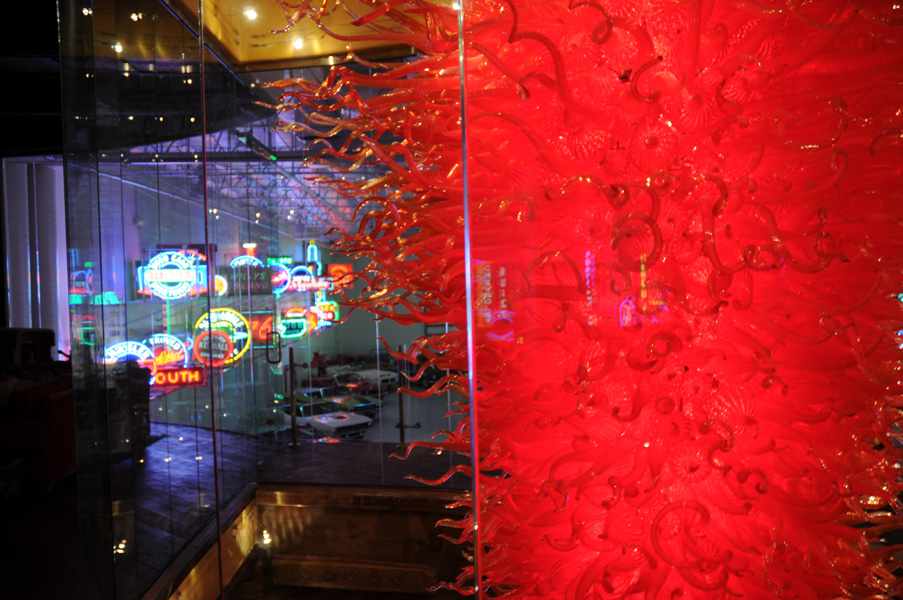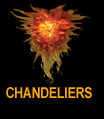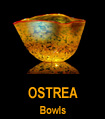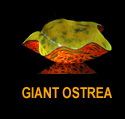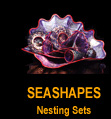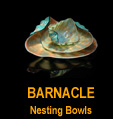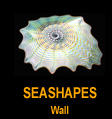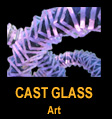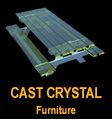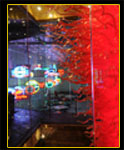By Stephanie Finnegan
A well-crafted life map can be pretty fragile. There’s that famous expression “You want to make God laugh? Make a plan.” Yes, career goals can shatter and, like Scottish poet Robert Burns speculated, the best-laid plans of mice and men often go awry.
Take the success story of glass artist and business visionary Robert Kaindl. His life was happily moving along as a general contractor who owned a construction business. Always interested in donating money and time to charity, he attended a fund-raiser and placed the winning bid for three glass-blowing lessons. That moment of kismet set Kaindl on a path that he never would have anticipated. He learned the craft by blowing glass with a local glass master, and realized he was a natural at this beautiful and expressive art form. This realization happened a decade ago, and over the next 10 years, he studied, improved, and evolved. He purchased/designed custom equipment and began to sell and market his own art glass.
Everyone—including Robert Kaindl himself—acknowledges that his rise has been meteoric, but reaching for the heights is nothing new for the Pacific Northwest entrepreneur. At the age of 14, Robert earned his fixed-wing pilot’s license, and today he also has his rotorcraft license. Here is a man who is not afraid to go it alone and to test his limits.
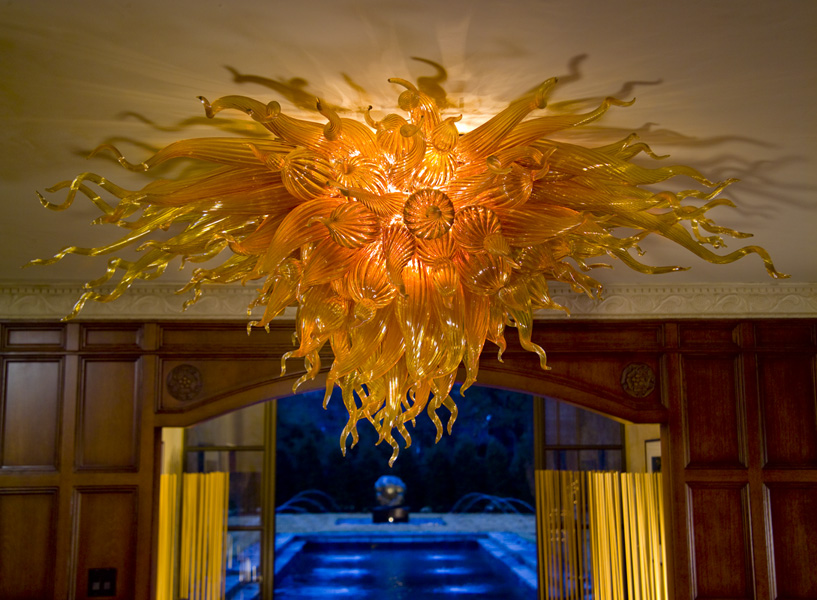
Today, enjoying his niche in the high-end world of glass art, Kaindl has his own studio and hot shop. Likewise, he and his team oversee an online gallery (robertkaindl.com) and are intimately involved in direct marketing and advertising inserts. Coming from a business owner’s background, Kaindl was able to incorporate those work ethics with his creative desires.
He “didn’t approach this as a hobby or the creation of art for art’s sake. Understanding basic business tenets, I hired a marketing and sales manager and a website developer to promote and build my brand.”
One of his associates mentions that “it is not difficult for Robert to move from left brain to right brain, and he doesn’t take himself so seriously that he wouldn’t create an art glass vessel to match a color theme chosen by an interior designer. His ambition is to sell his art glass—not to be a collector of his own work.”
Kaindl and his team appreciate the opportunities they have to make art and to make sound financial decisions. The company, which is based out of Washington State, has a business model that reflects the artist’s appreciation for the client—whether it’s a private individual or a large public institution: “Each client and project is different. We have a defined process and quality-assurance protocols that do not deviate, regardless of the project or its scale.”
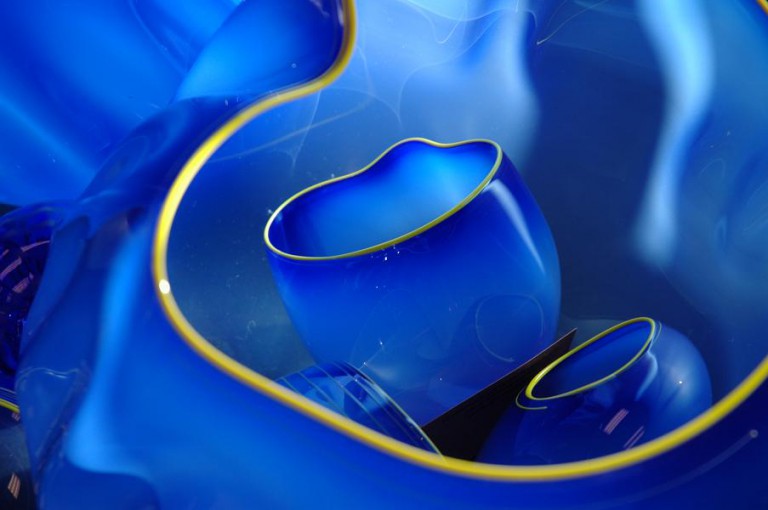
Gina DeBlanco, the senior vice president of sales and marketing for Robert Kaindl Glass Art, observes that another constant is that the clients—a homeowner or a hotel magnate—seek out Kaindl’s particular style, vision, and talents. “Robert’s art glass is not subtle,” DeBlanco shared. “This is ‘statement art glass.’ Robert is sensitive to both positive and negative space and will only create work that makes sense. He listens to the client’s objectives and is very considerate to their input. However, he will not compromise his vision.”
When asked what his ultimate goal is, Kaindl admitted that his mantra is “to exceed the client’s expectations with each project.”
DeBlanco mirrors the artist’s pledge to do his best and knows firsthand that his meticulous eye for detail has reaped appreciation and respect from his collectors: “We receive calls every day from clients sharing how moved and thrilled they are with their art glass. His artwork is an investment, and it is not lost on him what is required to make this level of commitment to art.”
These days, the Kaindl staff sells from the RK Signature Collection and works in tandem with individual collectors, interior designers, architectural firms, developers, corporations, galleries, and showrooms. Kaindl will customize the color themes for clients, but the forms remain the same (Anthias, Barnacle Nesting Sets, Celebration Series, Ostrea, and Wall SeaShapes).
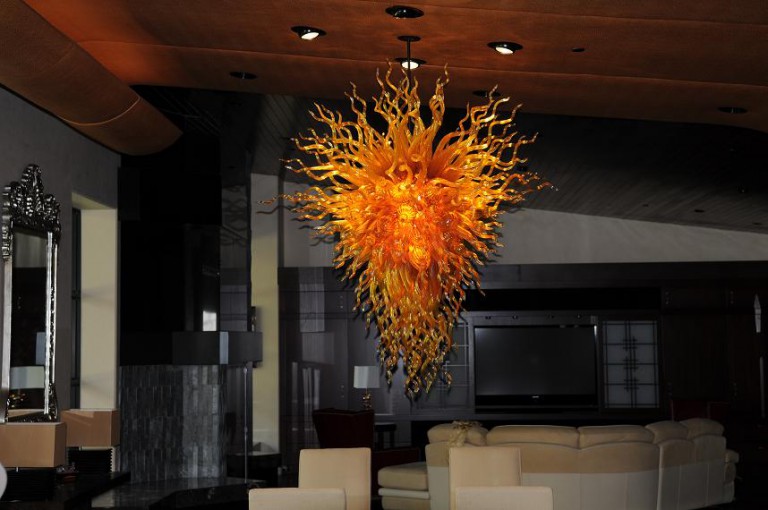
In a short 10 years, Robert Kaindl Glass Art has become a global enterprise. The artist travels all over the world, installing his glass creations. Each series has a particular range of sizes: Some of his handiwork can actually be nestled within the palm of a hand. Others are a noticeable 45 inches high. His chandeliers, which are majestic and mesmerizing, can measure between 30 inches to over a towering 20 feet or larger.
Kaindl is a tall man—standing 6 feet 6 inches—so he feels right at home with his Giant Series. He also is aware that his physical stature might seem to be in conflict with his soft, soulful side, but this dichotomy fuels his work and motivates him.
“I describe my Celebration Chandelier Series, for example, as a series of ‘visual contradictions.’ A 6-foot chandelier, for instance, weighs approximately 500 pounds, and it is suspended by a single cable. My chandeliers appear to be freeform and floating, yet they are a study of balance and symmetry.” The chandeliers appear to be sculptures that float in the air, suspended in their beauty and perfection. However, Kaindl emphasizes, these are more than what meets the eyes: “I designed the Celebration Chandelier Series to be completely functional. They are illuminated from within, which mimics the fire from which it was created. There are many variables to consider when your objective is to create flawless glass. I work exclusively with transparent colors. If you have bubbles or flaws, they will be apparent. I am a perfectionist. I love the beauty of pure glass without inclusions—each delicate, uninterrupted translucent piece. The effort is painstaking but well worth it.”
He and his team hand-blow each and every piece in their state-of-the-art Redmond, Wash., studio. While he works, he allows his imagination and his spirit to soar free. He is “inspired by nature and the classic Murano (Italy) glass-blowing techniques, which I infuse with my own edgy yet organic style. The inspiration for the Signature Collection was organic forms, specifically sea life. I have created several series based on my fascination with aquatic species and my passion for the preservation of their habitats.”
In addition to honoring the ecosystem through his art glass designs, Kaindl also is committed to giving donations and raising awareness of charities that help the natural landscape. That is one of his favorite components of being a success. He is able to give a portion of his income and inspire others to do so in the name of charitable outreach: “I hope that my contributions assist in finding the cure for cancer and other aggressive diseases. I hope that my donations and time spent raising awareness alleviate hunger, pain, and suffering for children and for animals.” These wishes are near and dear to his heart.
Besides his achievements in glass, Kaindl truly believes that his real legacy will be his son and his daughter: “I hope that I have instilled in them my faith, hope, love, ethics, and passion to dream. I hope that they live long and healthy lives.”
When pressed to discuss how his artwork will endure and what it will say about him, the artist is humbled by the possibility of being remembered. “To be remembered, that would be nice,” he muses. “I am living my mission. I love to meet my collectors/clients and make them happy. I am thrilled that I am present and living my passion every day. I am extremely fortunate to have achieved this level of success. I understand that it is not an easy journey. Art is subjective, and art is business. Understanding both of these things is critical to being sustainable.”

